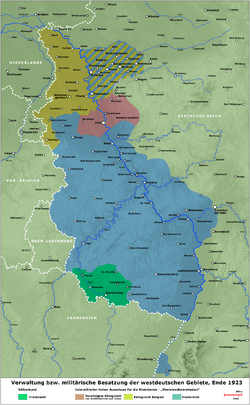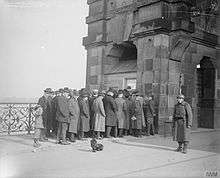Allied occupation of the Rhineland

— blue: France
— yellow: Belgium
— brown: United Kingdom
— stripes : Ruhr, occupied by France and Belgium
— green: Saar, occupied by France under the auspices of the League of Nations
The Allied occupation of the Rhineland took place following the armistice that brought the fighting of World War I to a close on 11 November 1918. The occupying armies consisted of American, Belgian, British and French forces. The terms of the armistice provided for the immediate evacuation of German troops from Belgium, France, and Luxembourg as well as Alsace-Lorraine within 15 days.[1]
French forces continued to occupy German territory in the Rhineland until the end of 1930, while France continued to control the smaller Saarland region until 1935.[2]
Periods
- First Armistice (11 november 1918 – 13 December 1918)
- First prolongation of the armistice (13 December 1918 – 16 January 1919)
- Second prolongation of the armistice (16 January 1919 – 16 February 1919)
- Third prolongation of the armistice (16 February 1919 – 10 January 1920)
- 1920: Foundation of Inter-Allied Rhineland High Commission (10 January 1920, Versailles Treaty paragraphs 428-431)
- 1930: under the terms of the 1925-26 Locarno Treaties, Allied troops withdrew
- 1936: Remilitarization of the Rhineland by German troops under Hitler, on March 7
Occupying forces

Belgian forces
This consisted of five divisions with its headquarters at Aachen, and with its troops stationed in Krefeld.[3]
British forces
The British Army entered German territory on 3 December 1918.[4] The British Army of the Rhine was established as the occupying force in March 1919. Based at Cologne, they published The Cologne Post.
French forces

The French Eighth Army and Tenth Army originally constituted the French forces involved in the occupation. On 21 October 1919, they were combined to form the French Army of the Rhine.

In 1919 France stationed between 25,000 and 40,000 French colonial soldiers in the Rhineland.[5] Assaults by Black soldiers in the French occupation army on local women[6] led to accusations of systemic rape and other atrocities targeting the German civilian population and attributed mainly to Senegalese Tirailleurs.[7] The events resulted in a widespread campaign by the German right-wing press, which dubbed them as "The Black Shame" (Die schwarze Schande or Die schwarze Schmach) and depicted them as a form of French humiliation of the German nation.[8] Furthermore, some German women married African soldiers from the occupying forces, while others had children by them out of wedlock (hence the disparaging label "Rhineland Bastards")[9] and were considered to increase the public disgrace.[10] General Henry Tureman Allen reported to the US Secretary of State that from the start of the occupation until June 1920 there were 66 cases of formal accusations against colored colonial troops, out of which there were 28 convictions, and admits there were many more unreported cases.[6] Despite these occasional cases, "the wholesale atrocities by French negro Colonial troops alleged in the German press, such as the alleged abductions, followed by rape, mutilation, murder and concealment of the bodies of the victims are false and intended as political propaganda".[11]
Ruhr occupation
In 1923, in response to German failure to pay reparations under the Treaty of Versailles, France and Belgium occupied the industrial Ruhr area of Germany, most of which lies across the river on the right bank of the Rhine, until 1925. Many Germans were killed during civil disobedience protests. e.g. against dismissal of German officials.[12][13]
United States forces

The American forces originally provided around 240,000 men in nine veteran divisions, nearly a third of the total occupying force. General John Pershing, commander of the American Expeditionary Force (AEF) on the Western Front, established the Third Army for the purpose, under the command of Major General Joseph T. Dickman.[14]
Third Army was assigned to occupy the northern sector of the Coblenz bridgehead. By July 1919, Third Army was disbanded, having been reduced to about 8,400 men, and was renamed the American Forces in Germany.
On 24 January 1923, the US Army withdrew from the occupation of the Rhine, vacating the Ehrenbreitstein Fortress, which was promptly occupied by the French.
See also
References
- ↑ Edmonds, (1943), p. 1
- ↑ Emmanuel Pénicaut. "L'armée française en Sarre, 1918-1930" (in French)., Revue historique des armées, Service historique de la défense.
- ↑ Pawley (2008) p. 41
- ↑ Philip Gibbs on the Allied Occupation of the Rhineland, December 1918 accessed 11 September 2010
- ↑ Wigger (2010) p. 35
- 1 2 "Finds Negro troops orderly on Rhine". New York Times. 20 February 1921.
Undoubtedly many cases have occurred where many girls or women have been assaulted by of the French colored Colonial troops... cases which were not included in official figures... natural desire to keep out...
- ↑ LES TIRAILLEURS SENEGALAIS ET L’ANTHROPOLOGIE COLONIALE UN LITIGE FRANCO-ALLEMAND AUX LENDEMAINS DE LA PREMIERE GUERRE MONDIALE, Hans-Jürgen Lüsebrink
- ↑ La « Honte Noire ». Racisme et propagande allemande après la Première Guerre mondiale, Estelle Fohr-Prigent
- ↑ Tina Campt, Other Germans: Black Germans and the Politics of Race, Gender, and Memory in the Third Reich (University of Michigan Press, 2004), p. 50 ff.
- ↑ Julia Roos, Women's Rights, Nationalist Anxiety, and the "Moral" Agenda in the Early Weimar Republic: Revisiting the "Black Horror" Campaign against France's African Occupation Troops. Central European History, 42 (September 2009), 473–508.
- ↑ FINDS NEGRO TROOPS ORDERLY ON RHINE; General Allen Reports Charges Are German Propaganda, 'Especially for America, New York Times, 20 February 1921
- ↑ "Anaconda Standard". 1923-02-10.
Twenty G e r m a n s w e r e said t o have been killed a n d s e v e r a l F r e n c h s o ld i e rs wo u n d e d when a mob a t Rapoch a t t e m p t e d to p r e v e n t t h e expulsion o f one h u n d r e d officials. P i c t u r e shows F r e n c h guard being doubled o u t si d e t h e s t a t i o n at Bochum f o ll o w i n g a collision b e t w e e n G e r m a n mob a n d t he F r e n c h
- ↑ "Hannover Evening Sun". 1923-03-15.
Three Germans killed in Ruhr by French sentries
- ↑ Pawley (2008) pp. 32–33
Bibliography
- Edmonds, J.E. (1987) [1943]. The Occupation of the Rhineland 1918–29. HMSO. ISBN 978-0-11-290454-0.
- Pawley, Margaret (2008). The Watch on the Rhine: The Military Occupation of the Rhineland, 1918–1930. I.B.Tauris. ISBN 978-1-84511-457-2.
- Wigger, Iris (2010). "'Black Shame' – the campaign against 'racial degeneration' and female degradation in interwar Europe". Race and Class. Institute of Race Relations. 51 (3). ISBN 978-1-84787-414-6. ISSN 0306-3968.
External links
| Wikimedia Commons has media related to Allied occupation of the Rhineland. |
- The French Occupation of the Rhineland, 1918–1930
- Map of Europe during the Occupation of the Rhineland at omniatlas.com